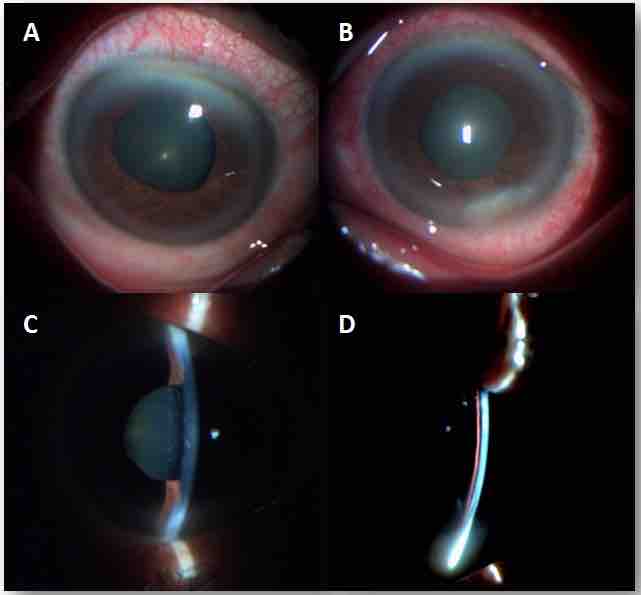Bilateral simultaneous acute angle closure in an adult Nepalese woman
Abstract
Purpose: To report a case of bilateral simultaneous angle closure in an adult Nepalese woman without any known secondary cause.
Methods: Observational case report.
Results: A 50-year-old Nepalese woman presented with decreased vision, pain, redness, and watering in both eyes with associated coloured haloes, nausea, and vomiting for 10 days. At presentation, her visual acuity was 20/400 in the right eye and hand motions close to face with accurate projection of rays in the left eye. Intraocular pressure was 38 mmHg in the right eye and 48 mmHg in the left eye without any antiglaucoma medications. A slit-lamp examination revealed bilateral circum-corneal conjunctival congestion, corneal edema, and shallow anterior chambers. Both pupils were mid-dilated and non-reactive to light. Gonioscopy showed closed angles in all four quadrants bilaterally. Posterior segment examination revealed normal optic disc with cup-disc-ratio of 0.3 in the right eye, and blurring of disc margin with cup-disc-ratio of 0.3 in the left eye. The patient was started on systemic acetazolamide 250 mg 4 times a day, topical brimonidine 0.2% and timolol 0.5% 2 times a day, and topical dexamethasone 6 times a day in both eyes, following which IOP reduced to 11 and 12 mmHg, respectively, the corneal edema subsided, but the anterior chamber remained shallow. Laser peripheral iridotomy was performed in the right eye and surgical peripheral iridectomy was performed in the left eye. After two weeks, vision improved to 20/30 in both eyes with normal intraocular pressure off antiglaucoma medications. Anterior chambers deepened significantly with clear corneas bilaterally. Gonioscopy at this stage showed essentially open angles with appositional closure in superior and temporal quadrants in the right eye and open angles in all four quadrants in the left eye. Posterior segment evaluation revealed normal optic disc in both eyes.
Conclusions: Bilateral simultaneous acute angle closure is a rare presentation with very few reported secondary causes. We report a case of bilateral simultaneous angle closure in an adult Nepalese woman without any known secondary cause. The case was successfully managed with laser peripheral iridotomy in the right eye and surgical peripheral iridectomy in the left eye.
References
2. Ates H, Kayikcioglu O, Andac K. Bilateral angle closure glaucoma following general anesthesia. Int Ophthalmol. 1999;23:129–30.
3. Srinivasan R, Kaliaperumal S, Dutta TK. Bilateral angle closure glaucoma following snake bite. J Assoc Physicians India. 2005;53:46–48.
4. Kaushik S, Sachdev N, Pandav SS, Gupta A, Ram J. Bilateral acute angle closure glaucoma as a presentation of isolated microspherophakia in an adult: case report. BMC Ophthalmol. 2006;6:29.
5. Kimura R, Sakai M, Otabe H. Transient shallow anterior chamber as initial symptom in Harada's syndrome. Arch Ophthalmol. 1981;99:1604–1606.
6. Levy J, Yagev R, Petrova A, Lifshitz T. Topiramate-induced bilateral angle-closure glaucoma. Can J Ophthalmol. 2006;41:221-5.
7. Cruciani F, Lorenzatti M, Nazzarro V, Abdolrahimzadeh S. Bilateral acute angle closure glaucoma and myopia induced by topiramate. Clin Ter. 2009;160:215-216.
8. Grewal DS, Goldstein DA, Khatana AK, Tanna AP. Bilateral angle closure following use of a weight loss combination agent containing topiramate. J Glaucoma. 2015;24:132-136.
9. Lee GC, Tam CP, Danesh-Meyer HV, Myers JS, Katz LJ. Bilateral angle closure glaucoma induced by sulphonamide-derived medications. Clin Experiment Ophthalmol. 2007;35:55-58.
10. Foster PJ. The epidemiology of primary angle closure and associated glaucomatous optic neuropathy. Semin Ophthalmol. 2002 Jun;17: 50-58.
11. Seah SK, Foster PJ, Chew PT, Jap A, Oen F, Fam HB, Lim AS. Incidence of acute primary angle - closure glaucoma in Singapore. An island-wide survey. Arch Ophthalmol. 1997; 115:1436-1440.

Copyright (c) 2018 Asian Journal of Ophthalmology

This work is licensed under a Creative Commons Attribution 4.0 International License.
Authors who publish with this journal agree to the following terms:
- Authors retain copyright and grant the journal right of first publication, with the work twelve (12) months after publication simultaneously licensed under a Creative Commons Attribution License that allows others to share the work with an acknowledgement of the work's authorship and initial publication in this journal.
- Authors are able to enter into separate, additional contractual arrangements for the non-exclusive distribution of the journal's published version of the work (e.g., post it to an institutional repository or publish it in a book), with an acknowledgement of its initial publication in this journal.
- Authors are permitted and encouraged to post their work online (e.g., in institutional repositories or on their website) prior to and during the submission process, as it can lead to productive exchanges, as well as earlier and greater citation of published work (See The Effect of Open Access).


